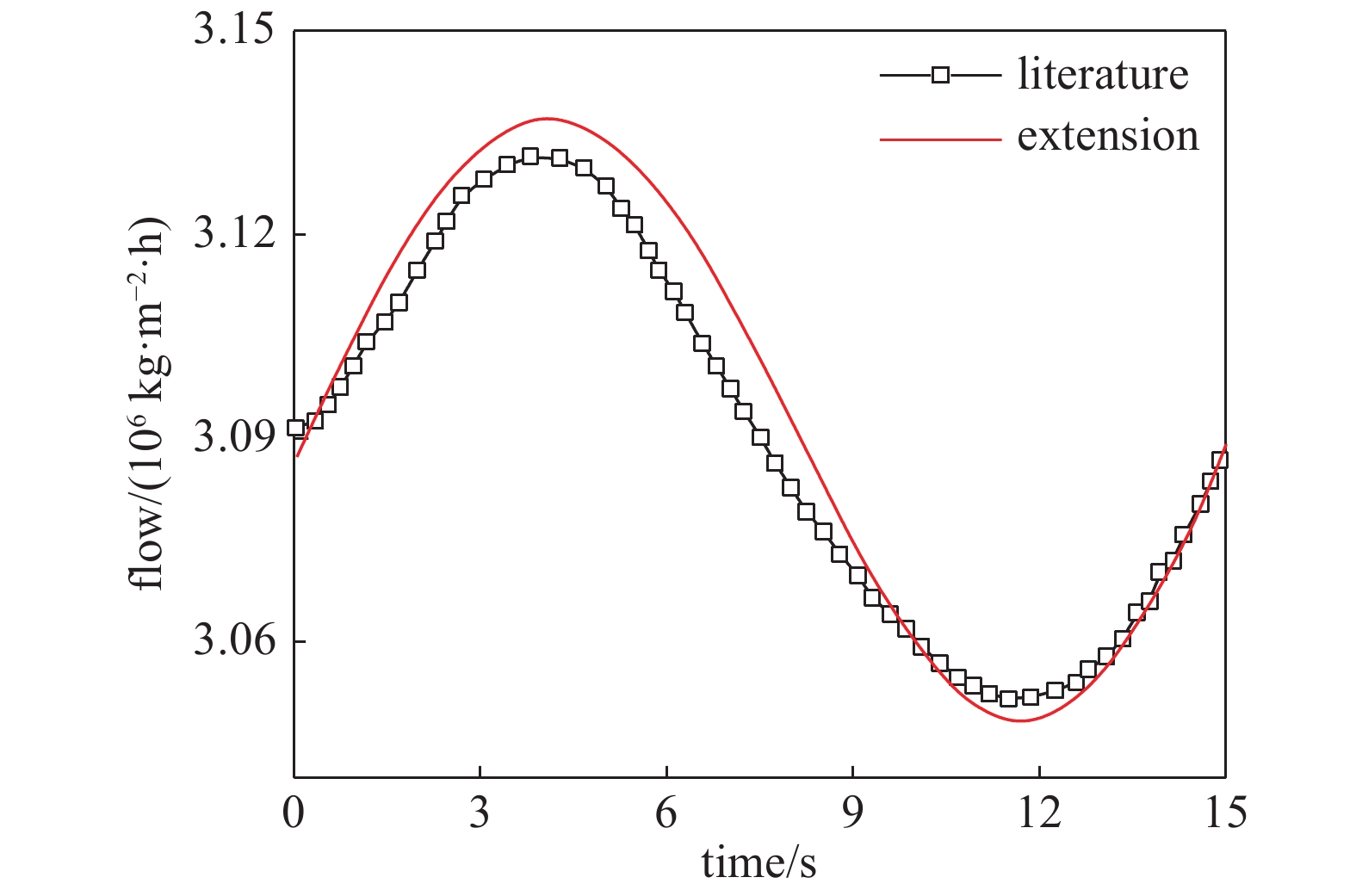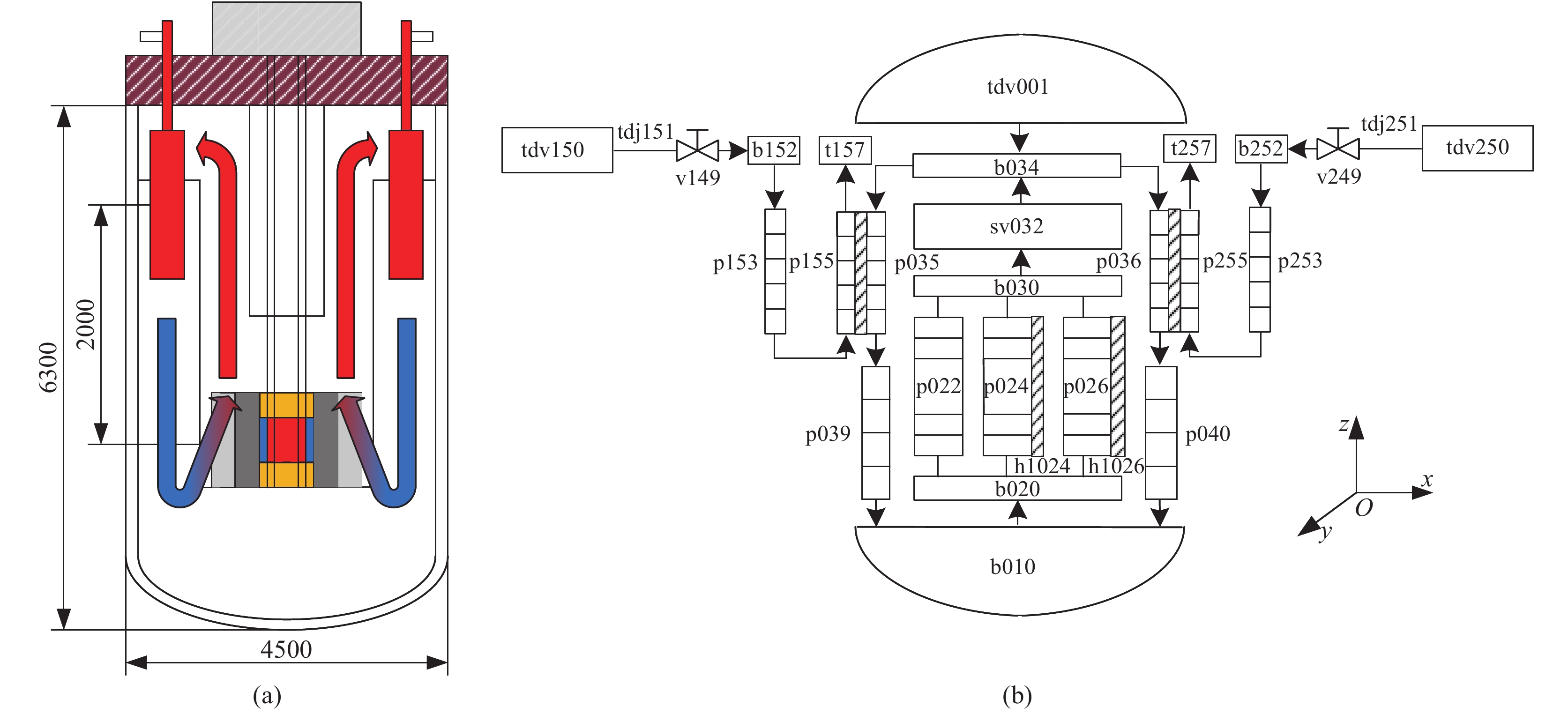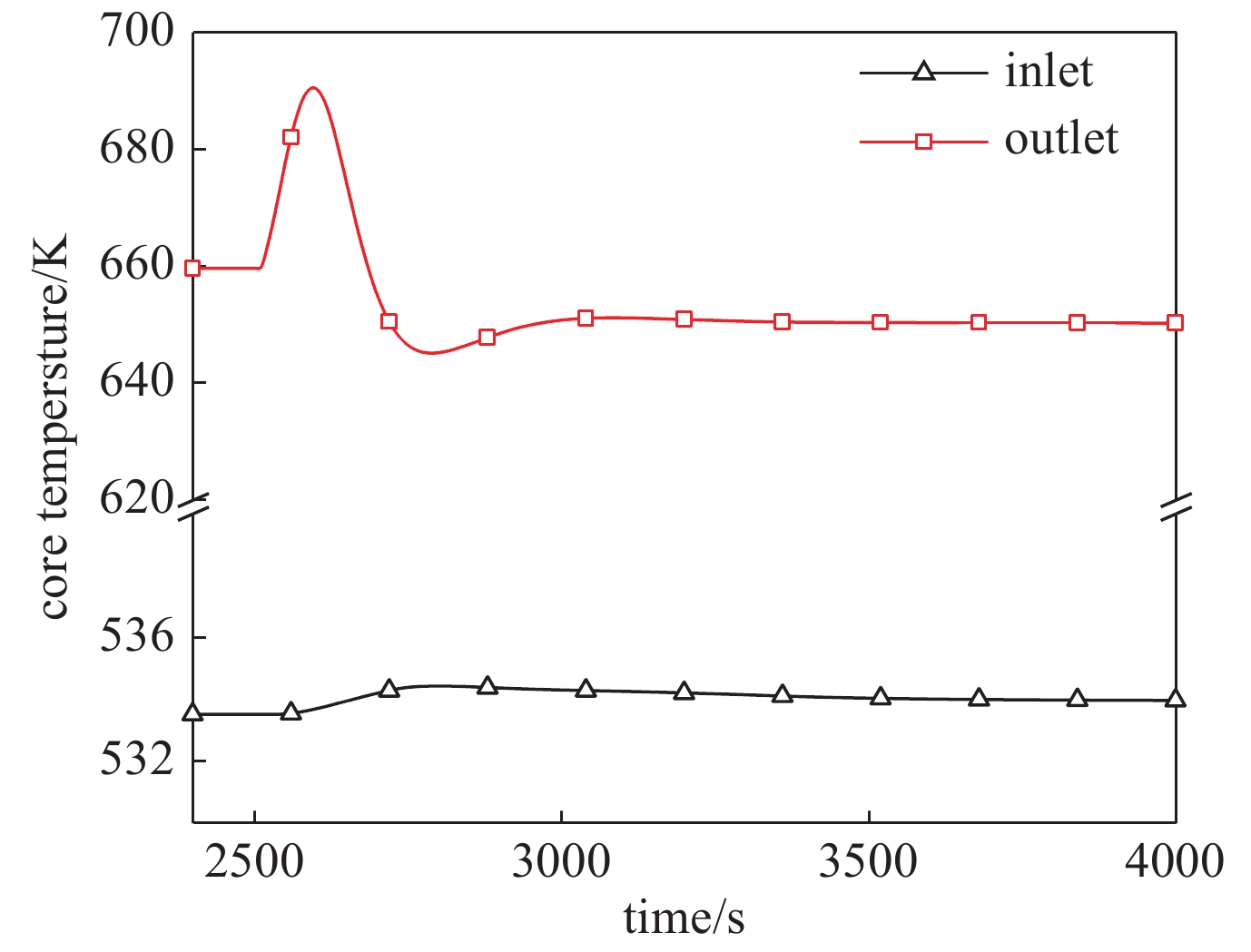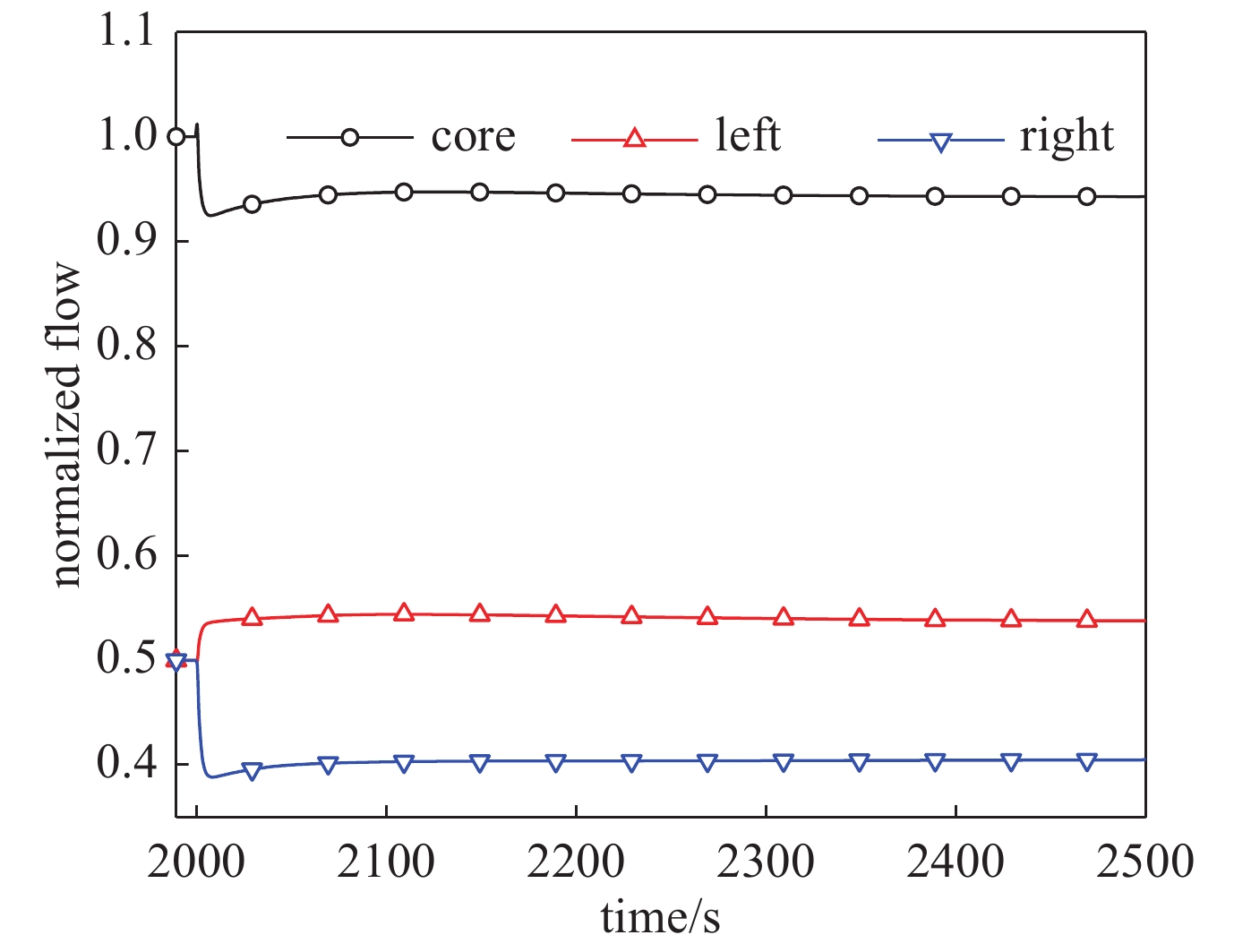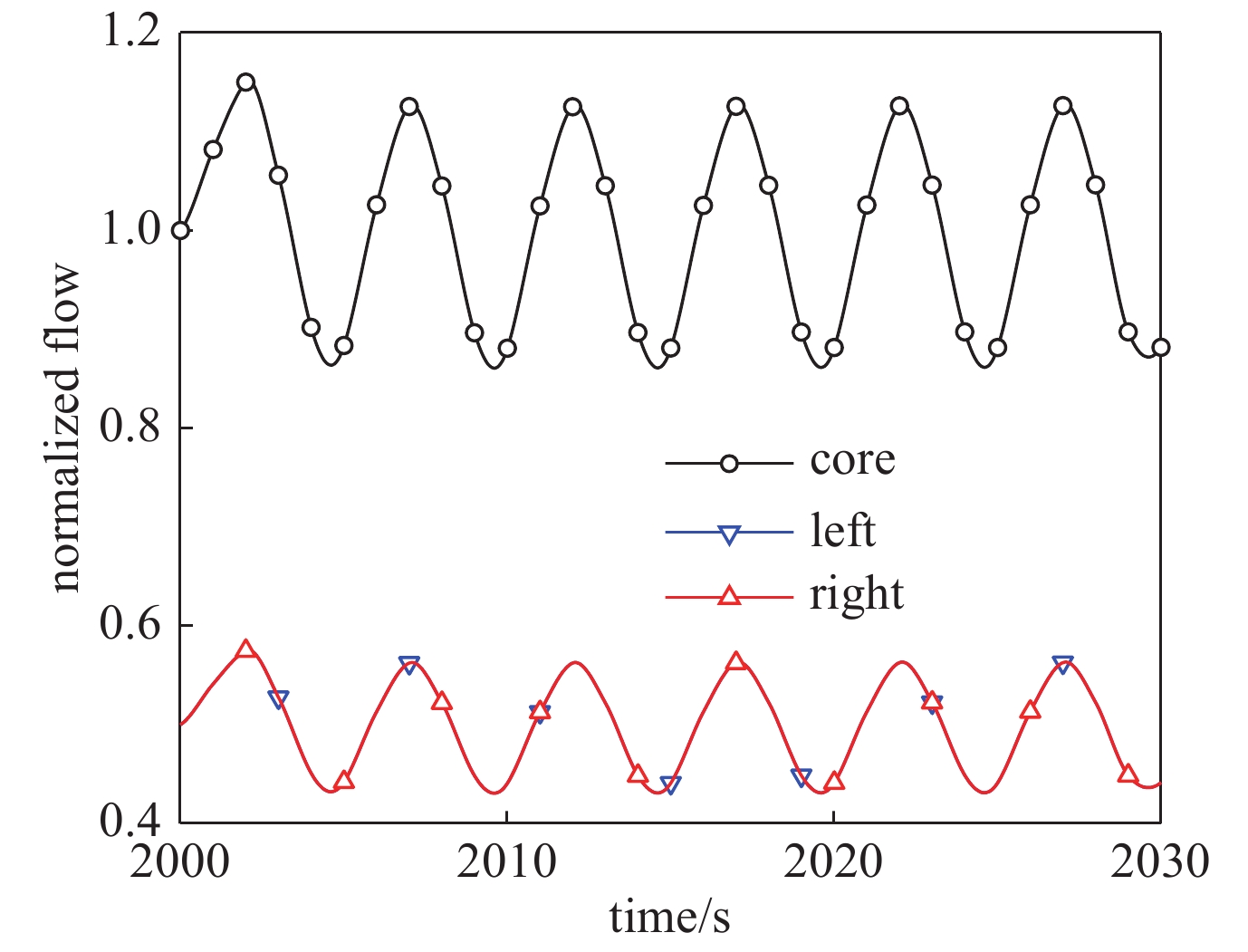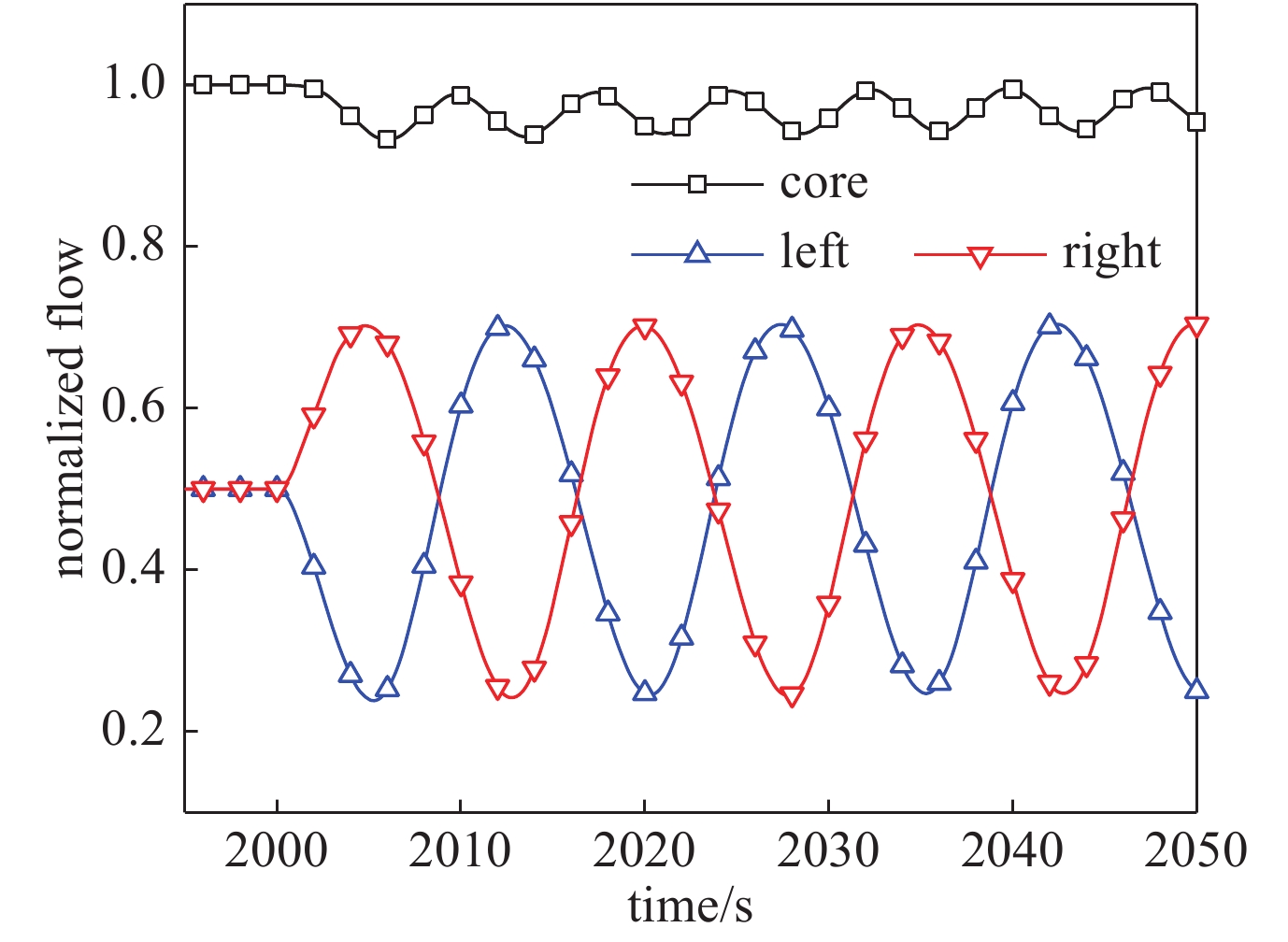Asymmetrical operation characteristics of natural circulation lead-bismuth reactor under ocean conditions
-
摘要: 基于二次开发RELAP5/MOD3.1程序,分析了典型海洋条件下的10 MW自然循环铅铋反应堆偏环运行特性。分析结果表明:反应堆在倾斜条件下偏环运行时,其系统参数对倾角变化敏感性较弱;起伏条件下,偏环运行导致流量的波动幅度降低为9%,出口温度降低约16 K。起伏幅度越大、流量波动越剧烈;起伏周期越大、流量震荡越明显,但影响效果也在减弱;摇摆条件下,堆芯流量、出口温度降低,反应堆引入更高的安全裕量;摇摆幅度越大、摇摆周期越小,流量波动幅度越大,且堆芯出口温度对周期变化敏感性明显高于摇摆幅度变化。Abstract: To ensure the vitality of naval nuclear power at all times, the natural cycle lead-bismuth reactor loop will take partial loop operation when it fails under marine conditions. However, there are few studies on the partial loop operation characteristics of lead-bismuth reactor under marine conditions. Based on the secondary development of RELAP5/MOD3.1 program, the off-loop operation characteristics of a 10 MW natural cycle lead-bismuth reactor under typical oceanic conditions are analyzed. The analysis results show that the system parameters of the reactor are less sensitive to the change of tilt angle when the reactor is operating under inclined conditions. Under undulating conditions, the fluctuation of flow rate is reduced by 9% and the outlet temperature is reduced by about 16 K. The larger the undulating amplitude, the more drastic the flow rate fluctuation; the larger the undulating period, the more obvious the flow rate oscillation, but the effect is also weakening. Under rocking conditions, the core flow and outlet temperature are reduced and the reactor introduces higher safety margins. The larger the swing amplitude and the smaller the swing period, the larger the flow fluctuation, and the core outlet temperature is significantly more sensitive to the cycle change than the swing amplitude change.
-
Key words:
- ocean conditions /
- lead-bismuth reactor /
- RELAP5 /
- natural circulation /
- asymmetric loop operation
-
表 1 RELAP5中的液相铅铋物性关系式
Table 1. Formula of RELAP5 program for liquid LBE
parameter thermodynamic properties density ρLBE[kg⋅m−3]=11096.0−1.3036×TLBE saturation vapor pressure ps(LBE)[Pa]=1.11×1010⋅exp(−22552.0TLBE) heat capacity cp(LBE)[J⋅kg−1⋅K−1]=159.0−2.72×10−2×TLBE+7.12×10−6×T2LBE internal energy U(LBE)[J⋅kg−1]=159.0(TLBE−TM)+2.72×10−2(T2LBE−T2M)2+7.12×10−6(T3LBE−T3M)3
TM=398.15Kenthalpy h(LBE)[J⋅kg−1]=U+pv entropy S(LBE)[J⋅kg−1⋅K−1]=159.0lnTLBETM+2.72×10−2(TLBE−TM)+7.12×10−6(T2LBE−T2M)2 thermal coefficient of expansion β(LBE)[K−1]=1(8383.2−TLBE) pressure coefficient of expansion κ(LBE)[Pa−1]=1(11096.0−1.3036TLBE)(1773.0+0.1049TLBE+2.87⋅10−4T−4LBE)2 viscosity η(LBE)[Pa⋅s]=4.94×10−4×exp(754.1TLBE) surface tension σ(LBE)[N⋅m−1]=0.367−5.5⋅10−5(TLBE−1073.15) thermal conductivity λ(LBE)[W⋅m−1⋅K−1]=3.61+1.517×10−2TLBE−1.741×10−6T2LBE 表 2 自然循环实验值与计算值对比
Table 2. Comparison of experimental value and calculated value of natural circulation
parameter MH flow/(kg/s) TS flow/(kg/s) total flow/(kg/s) MH inlet temperature/K MH outlet temperature/K TS inlet temperature/K TS outlet temperature/K experiment 0.238 0.293 0.533 473.28 556.63 457.53 567.14 extension 0.242 0.29 0.533 473.19 559.99 473.19 565.44 error/% −1.68 1.023 0 0.019 −0.603 0.492 0.300 RELAP5-3D 0.238 0.296 0.534 473.2 561.23 473.2 561.75 error/% 0 −1.023 −0.187 0.017 −0.826 0.490 0.950 表 3 堆芯关键参数设计值与计算值对比
Table 3. Comparison of design values and calculated values of key parameters in core
parameter power/MW inlet temperature/K outlet temperature/K flow/(kg/s) flow rate(m/s) design value 10 533 663 529.4 0.12356 extension 10 533.52 659.63 529.28 0.12133 error/% 0 −0.098 0.508 0.022 1.804 RELAP5-3D 10 533.34 659.1 529.84 0.12123 error/% 0 −0.064 0.588 −0.083 1.886 -
[1] 吴宜灿, 王明煌, 黄群英, 等. 铅基反应堆研究现状与发展前景[J]. 核科学与工程, 2015, 35(2):213-221. (Wu Yican, Wang Minghuang, Huang Qunying, et al. Development status and prospects of lead-based reactors[J]. Nuclear Science and Engineering, 2015, 35(2): 213-221 doi: 10.3969/j.issn.0258-0918.2015.02.004 [2] 王泽鸣. VVER-1000偏环运行蒸汽发生器换热特性数值模拟研究[D]. 哈尔滨: 哈尔滨工业大学, 2016Wang Zeming. Numerical simulation of steam generator heat transfer characteristics in VVER-1000 asymmetric operation[D]. Harbin: Harbin Institute of Technology, 2016 [3] 程建平. 基于CFD的四环路压水堆偏环运行数值模拟[D]. 哈尔滨: 哈尔滨工业大学, 2015Cheng Jianping. Numerical simulation on four-loop PWR at asymmetric operation conditions based on CFD[D]. Harbin: Harbin Institute of Technology, 2015 [4] 王苏豪, 黄善清, 高胜, 等. 液态铅铋实验回路KYLIN-Ⅱ热平衡理论分析研究[J]. 核科学与工程, 2013, 33(4):409-413,428. (Wang Suhao, Huang Shanqing, Gao Sheng, et al. Analysis on heat balance for liquid lead-bismuth experimental loop KYLIN-II[J]. Nuclear Science and Engineering, 2013, 33(4): 409-413,428 [5] Orlova E E, Smirnov V P, Vlasenko A E, et al. Celsist subchannel module aided simulation of liquid-metal coolant flow in experimental FA[J]. Atomic Energy, 2020, 128(2): 71-77. doi: 10.1007/s10512-020-00653-z [6] Martelli D, Forgione N, Di Piazza I, et al. HLM fuel pin bundle experiments in the CIRCE pool facility[J]. Nuclear Engineering and Design, 2015, 292: 76-86. doi: 10.1016/j.nucengdes.2015.06.004 [7] 张家心, 王成龙, 赵寒冰, 等. RELAP5铅铋快堆模型拓展及验证[J]. 原子能科学技术, 2021, 55(7):1260-1267. (Zhang Jiaxin, Wang Chenglong, Zhao Hanbing, et al. RELAP5 modification and verification for lead-bismuth fast reactor[J]. Atomic Energy Science and Technology, 2021, 55(7): 1260-1267 [8] Kumari I, Khanna A. Preliminary validation of RELAP5/Mod4.0 code for LBE cooled NACIE facility[J]. Nuclear Engineering and Design, 2017, 314: 217-226. doi: 10.1016/j.nucengdes.2017.02.004 [9] Angelucci M, Martelli D, Barone G, et al. STH-CFD codes coupled calculations applied to HLM loop and pool systems[J]. Science and Technology of Nuclear Installations, 2017, 2017: 1936894. [10] Ishida I, Tomiai I. Development of analysis code for thermal hydro-dynamics of marine reactor under multi-dimensional ship motions, RETRAN-02/GRAV[R]. Tokyo: Atomic Energy Research Inst, 1992: 135. [11] 王冰. 海洋条件下核反应堆热工水力分析程序开发[D]. 哈尔滨: 哈尔滨工程大学, 2017Wang Bing. The development of a thermal hydraulic analysis code of nuclear reactor under ocean conditions[D]. Harbin: Harbin Engineering University, 2017 [12] 谭思超, 高璞珍, 苏光辉. 摇摆运动条件下自然循环复合型脉动的实验研究[J]. 原子能科学技术, 2008, 42(11):1007-1011. (Tan Sichao, Gao Puzhen, Su Guanghui. Experimental research on natural circulation complex oscillations under rolling motion conditions[J]. Atomic Energy Science and Technology, 2008, 42(11): 1007-1011 [13] Murata H, Sawada K I, Kobayashi M. Experimental investigation of natural convection in a core of a marine reactor in rolling motion[J]. Journal of Nuclear Science and Technology, 2000, 37(6): 509-517. doi: 10.1080/18811248.2000.9714924 [14] Ishida T, Yoritsune T. Effects of ship motions on natural circulation of deep sea research reactor DRX[J]. Nuclear Engineering and Design, 2002, 215(1/2): 51-67. [15] 刘志鹏, 王成龙, 张大林, 等. 运动条件下铅铋反应堆热工水力特性研究[J]. 原子能科学技术, 2021, 55(5):811-821. (Liu Zhipeng, Wang Chenglong, Zhang Dalin, et al. Thermal-hydraulic analysis of lead-bismuth reactor under moving condition[J]. Atomic Energy Science and Technology, 2021, 55(5): 811-821 [16] 刘佩琪. 摇摆条件下一体化自然循环铅基快堆物理-热工耦合特性初步研究[D]. 衡阳: 南华大学, 2019Liu Peiqi. Preliminary study on physical-thermal coupling technology of integrated reactor under rolling conditions[D]. Hengyang: University of South China, 2019 [17] 郑云涛. 小型核反应堆非对称运行数值分析[D]. 哈尔滨: 哈尔滨工程大学, 2014Zheng Yuntao. A numerical analysis of asymmetric operation on the small nuclear reactors[D]. Harbin: Harbin Engineering University, 2014 [18] Um K S, Ryu S H, Choi Y S, et al. Experimental and computational study of the core inlet temperature pattern under asymmetric loop conditions[J]. Nuclear Technology, 1999, 125(3): 305-315. doi: 10.13182/NT99-A2949 [19] Grudev P, Pavlova M. Simulation of loss-of-flow transient in a VVER-1000 nuclear power plant with RELAP5/MOD3.2[J]. Progress in Nuclear Energy, 2004, 45(1): 1-10. doi: 10.1016/j.pnucene.2004.08.001 [20] Espinoza S, Hugo V, Böttcher M. Investigations of the VVER-1000 coolant transient benchmark phase 1 with the coupled system code RELAP5/PARCS[J]. Progress in Nuclear Energy, 2006, 48(8): 865-879. doi: 10.1016/j.pnucene.2006.06.004 [21] Fazio C, Sobolev V, Aerts A, et al. Handbook on lead-bismuth eutectic alloy and lead properties, materials compatibility, thermal-hydraulics and technologies[R]. ISBN 978-92-64-99002-9. OECD/NEA, 2015. [22] The RELAP5-3D Code Development Team. RELAP5-3D code manual volume IV: models and correlations[R]. INEEL-EXT-98-00834. [23] Borishanskii V M, Gotovskii M A, Firsova É V. Heat transfer to liquid metals in longitudinally wetted bundles of rods[J]. Soviet Atomic Energy, 1969, 27(6): 1347-1350. doi: 10.1007/BF01118660 [24] Rehme K. Pressure drop performance of rod bundles in hexagonal arrangements[J]. International Journal of Heat and Mass Transfer, 1972, 15(12): 2499-2517. doi: 10.1016/0017-9310(72)90143-3 [25] 文俊. CiADS铅基反应堆堆芯流量分配设计与优化[D]. 兰州: 中国科学院大学(中国科学院近代物理研究所), 2021Wen Jun. Analysis and optimization of flow distribution for the CiADS lead-based reactor core[D]. Lanzhou: University of Chinese Academy of Sciences (Institute of Modern Physics, Chinese Academy of Sciences, 2021 [26] Grishchenko D, Jeltsov M, Kööp K, et al. The TALL-3D facility design and commissioning tests for validation of coupled STH and CFD codes[J]. Nuclear Engineering and Design, 2015, 290: 144-153. doi: 10.1016/j.nucengdes.2014.11.045 [27] Papukchiev A, Jeltsov M, Kööp K, et al. Comparison of different coupling CFD–STH approaches for pre-test analysis of a TALL-3D experiment[J]. Nuclear Engineering and Design, 2015, 290: 135-143. doi: 10.1016/j.nucengdes.2014.11.008 [28] Kööp K. Application of a system thermal-hydraulics code to development of validation process for coupled STH-CFD codes[D]. ISBN 978-91-7729-727-7 , 2018. [29] Grishchenko D, Papukchiev A, Liu Chunyu, et al. TALL-3D open and blind benchmark on natural circulation instability[J]. Nuclear Engineering and Design, 2020, 358: 110386. doi: 10.1016/j.nucengdes.2019.110386 [30] 王占伟. 摇摆运动下冷却剂低流速流动、传热特性研究[D]. 哈尔滨: 哈尔滨工程大学, 2013Wang Zhanwei. The flow and heat transfer characteristics for low flow rate flow under rolling motion conditions[D]. Harbin: Harbin Engineering University, 2013 [31] Ishida I, Kusunoki T, Murata H, et al. Thermal-hydraulic behavior of a marine reactor during oscillations[J]. Nuclear Engineering and Design, 1990, 120(2/3): 213-225. 期刊类型引用(8)
1. 郑伟伟,马世榜. 利用激光-电磁超声检测钛钢复合板脱粘. 应用激光. 2022(05): 102-108 .  百度学术
百度学术2. 郑伟伟,马世榜. 基于横波衍射法应用激光-电磁超声检测内部缺陷. 激光与红外. 2022(11): 1622-1628 .  百度学术
百度学术3. 宋艳,马世榜. 利用激光超声纵波的衍射信号测量开口裂纹. 激光与红外. 2021(01): 9-14 .  百度学术
百度学术4. 宋艳,马世榜,张开飞. 热弹激光超声激励及缺陷检测的有限元分析. 激光技术. 2021(02): 246-251 .  百度学术
百度学术5. 王玉庆,王云霞,马世榜. 基于衍射横波的裂纹激光超声检测方法. 激光技术. 2019(04): 110-114 .  百度学术
百度学术6. 贾中青,张振振,姬光荣. 离焦量对激光超声测厚信号影响的理论和实验研究. 红外与激光工程. 2017(S1): 13-18 .  百度学术
百度学术7. 闫政. 激光超声波探测中的智能感应设备的优化设计. 激光杂志. 2016(12): 34-38 .  百度学术
百度学术8. 马健,赵扬,张振振,高岩,孙继华,巨阳. 斜入射激光支持燃烧波时纵波声场的指向性. 强激光与粒子束. 2016(02): 25-29 .  本站查看
本站查看其他类型引用(7)
-






 下载:
下载:

